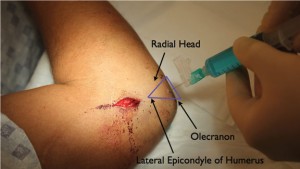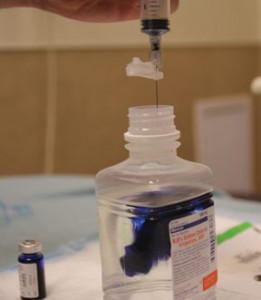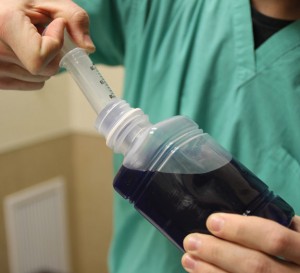Today, instead of talking about tapping a joint to pull fluid out, we’re going to talk about tapping a joint to put fluid in. Methylene blue, in fact.
The methylene blue joint injection test is a fast and simple bedside test that can be performed in the ED to assess joint capsule integrity in periarticular trauma in which there is suspicion for involvement of joint space. It’s very easy to see and safe for use within the joint capsule. When you have an open wound such as laceration in close proximity to a joint such as the knee, elbow, or ankle, you must consider the possibility that it is deep enough to involve the joint capsule. If there is involvement, then the management is drastically different. You cannot just close that laceration and send them home. If there is joint involvement, they need emergent OR washout and management with ortho.
The tapping of a joint part is the same as you normally would do for a diagnostic tap. We won’t go over the actual tapping instructions in this post, but you use the same usual landmarks you would for any given joint.
To create your methylene blue solution, instill 2mL of methylene blue into a 500mL bottle of NS. As with a typical arthrocentesis, you’ll insert your needle into the joint while pulling back with negative pressure until you are able to draw back on the syringe and see a flash of synovial fluid. At this point, hold the needle in place and replace the syringe with one filled with methylene blue. If you are in the joint capsule, you should be able to push this blue fluid in with ease. The amount of fluid you infuse into the joint space will depend on the what joint as they are different in size. It can range widely anywhere from 20mL in an elbow to 200mL in a knee.
The sensitivity of this test increases with the amount you infuse into it. For this reason, it is important to get adequate volume into the joint. Be aware that this procedure can actually be very painful for the patient as volume and pressure builds up in the joint capsule. I typically provide some analgesia prior to and during this procedure. Another recommendation is to examine the joint under full range of motion to check for leakage as well.
If methylene blue exudes from the wound site at any point, stop and call ortho for the OR. If there is no leakage, then typical wound care is likely appropriate. Afterwards, you should try to pull out as much of the methylene blue as you can for the patient’s comfort. Whatever is left will resorb eventually as well.
Sources
http://www.lasvegasemr.com/foam-blog/knee-capsule-violation-bedside-rule-out-test
http://crashingpatient.com/wp-content/uploads/2011/07/How-to-Confirm-Ankle-Joint-Penetration.pdf




